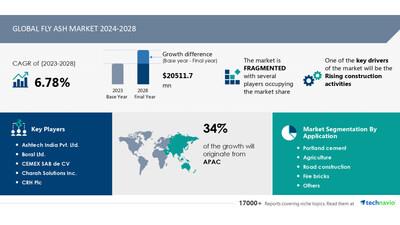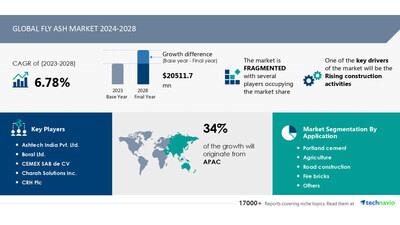Fly Ash Market Size Is Set To Grow By USD 20.51 Billion From 2024-2028, Rising Construction Activities Boost The Market, Technavio
| Fly Ash Market Scope |
|
| Report Coverage |
Details |
| Base year |
2023 |
| Historic period |
2018 - 2022 |
| Forecast period |
2024-2028 |
| Growth momentum & CAGR |
Accelerate at a CAGR of 6.78% |
| Market growth 2024-2028 |
USD 20511.7 million |
| Market structure |
Fragmented |
| YoY growth 2022-2023 (%) |
5.9 |
| Regional analysis |
APAC, North America, Europe, Middle East and Africa, and South America |
| Performing market contribution |
APAC at 34% |
| Key countries |
US, China, India, Germany, and United Arab Emirates |
| Key companies profiled |
Ashtech India Pvt. Ltd., Boral Ltd., CEMEX SAB de CV, Charah Solutions Inc., CRH Plc, Ecocem Ireland Ltd., HeidelbergCement AG, Holcim Ltd., National Minerals Corp., NTPC Ltd., Salt River Materials Group, Sephaku Holdings Ltd., Suyog Elements India Pvt. Ltd., The SEFA Group LLC, Titan Cement Group, Usb Chemicals, and Waste Management Inc. |
Market Driver
The global construction industry is experiencing significant growth, with an anticipated increase in output of over USD15 trillion by 2030. Major contributors to this growth include China, the US, and India, accounting for over 55% of the market. Cement and bricks are the most widely used materials in construction, making up a substantial portion of resources consumed in building and infrastructure projects. In response to increasing demand and environmental concerns, eco-friendly construction materials are gaining popularity. One such innovation is Low-Carbon Cement (LC3), also known as Limestone Calcined Clay Portland Cement. This initiative, led by research institutes in India and the Swiss government, aims to produce more cement with less clinker, extending limestone mine production by 45-65% and reducing CO2 emissions by up to 31%. The production of 250 million tons of LC3 could potentially reduce annual CO2 emissions by approximately 79.5 million tons. This breakthrough technology benefits both the cement industry and the environment by increasing resource efficiency and reducing carbon footprint.
The Fly Ash market is experiencing significant growth, particularly in the road construction industry, due to its usage as an eco-friendly material. With stringent environmental regulations, the demand for fly ash as a replacement for traditional materials like Portland Cement is increasing. Two main types of fly ash, Class F and Class C, offer varying compressive strengths and are used in embankments, road stabilization, and waste stabilization. However, challenges like sulfate attack and alkali-silica reaction must be addressed. Mining and oilfield industries are major contributors to fly ash production. In road construction, fly ash is used as an additive for oilfield service applications and in oil well cement. Additionally, fly ash is utilized in building materials, power stations, and coal industries for wastewater management and agriculture soil restoration. Fly ash is also used in geopolymer concrete production, which is a sustainable alternative to traditional concrete. Key components like sodium silicate and sodium hydroxide are used in the production of glass, ceramics, and metal refining, further expanding the market. The use of fly ash in these industries reduces carbon emissions, contributing to sustainable development.
Discover 360° analysis of this market. For complete information, schedule your consultation -
Book Here!
Market
Challenges
-
Fly ash is a crucial component in concrete production, contributing to a decrease in water content without affecting workability, thereby increasing its usage from 15-25% to 40-60% by mass. However, high volume usage may lead to extended setting times and slower strength development, particularly in cold European regions. The quality of fly ash is paramount, as poor-quality ash can enhance permeability, potentially damaging structures. Traditional builders have expressed resistance due to fly ash's efflorescence tendency and concerns over freezing and thaw performance. Other challenges include slow strength gain, seasonal limitations, and increased air entraining admixture requirements.
The Fly Ash market faces several challenges in its growth trajectory. Substitute materials like blast furnace slag and silica fume pose competition. Coal combustion residuals, the primary source of fly ash, require careful management due to environmental consciousness. The Road Construction segment and Agricultural category offer significant opportunities, with fly ash used as road paving materials and stabilizing agents. However, challenges like permeability and efflorescence in concrete applications persist. Infrastructure development in rail networks and roadways presents potential markets, but proper disposal of fly ash remains a concern. Coal combustion chambers in thermal power plants must comply with emission control equipment like scrubbers, electrostatic precipitators, and fabric filters. Cementitious materials, including Pozzolanic additives, glass-ceramics, and glass materials, find applications in various industries like ceramics, bricks, and concrete. Government departments push for commercialization of fly ash in infrastructure construction and non-residential establishments. Precast products, blocks, panels, roof tiles, and stabilizing agents for sub-grade and base materials are in demand. Ultimately, environmental sustainability is crucial to the Fly Ash market's growth.
For more insights on driver and challenges
-
Request a
sample report!
Segment Overview
This fly ash market report extensively covers market segmentation by
-
1.1 Portland cement
1.2 Agriculture
1.3 Road construction
1.4 Fire bricks
1.5 Others
-
2.1 Class F
2.2 Class C
-
3.1 APAC
3.2 North America
3.3 Europe
3.4 Middle East and Africa
3.5 South America
For more information on market segmentation with geographical analysis including forecast (2024-2028) and historic data (2017-2021) - Download a Sample Report
Research Analysis
The Fly Ash market is primarily associated with the power generation industry, where it is produced as a by-product of Coal combustion in thermal power plants. Fly Ash, a fine powder, is rich in silica, alumina, iron, and other minerals, making it an excellent building material. It is used as a pozzolanic additive in Portland Cement production, reducing the need for virgin raw materials and lowering carbon emissions. In infrastructure development, fly ash is used for road paving and in the production of cementitious materials. In the construction sector, it is used in both residential and non-residential construction as a substitute for sand and gravel in concrete production. Its use in emission control equipment, such as scrubbers, electrostatic precipitators, and fabric filters, also helps in reducing carbon emissions from power stations. Additionally, fly ash is used in the production of glass-ceramics and glass materials. However, the improper disposal of fly ash through dumping can pose environmental concerns. Sustainable development and infrastructure growth are key drivers for the Fly Ash market.
Market Research Overview
The Fly Ash market is a significant byproduct of coal combustion in power stations, which finds extensive applications in various industries. Building materials are a major segment for fly ash, with its usage as a pozzolanic additive in Portland cement, improving its properties such as compressive strength and reducing carbon emissions. Coal combustion residuals are utilized in the production of cementitious materials like geopolymer concrete, sodium silicate, and sodium hydroxide. Fly ash also finds applications in the manufacturing of glass, ceramics, and metal refining. In the infrastructure sector, it is used in road construction, rail networks, and embankments as a stabilizing agent and base material. The residential and non-residential construction sectors use fly ash in concrete production, reducing the need for virgin materials and promoting environmental sustainability. The Road Construction segment and Agricultural category are significant end-users, with fly ash being used as sub-grade materials and soil conservation agents. The market is driven by the increasing demand for eco-friendly materials and stringent environmental regulations. Class F and Class C ash are the two major types, with Class F ash having a lower calcium content and higher silica content, making it suitable for use in cement and concrete production. Fly ash is also used in waste stabilization, mining, oilfield service, and road stabilization. Its usage in agriculture soil restoration and wastewater management is gaining popularity due to its ability to improve soil quality and reduce water pollution. The market is expected to grow significantly in oil-producing countries due to the increasing demand for oilfield cement and the need for environmental consciousness in the mining and oil industries.
Table of Contents:
1 Executive Summary
2 Market Landscape
3 Market Sizing
4 Historic Market Size
5 Five Forces Analysis
6 Market Segmentation
-
Application
-
Portland Cement
Agriculture
Road Construction
Fire Bricks
Others
-
Class F
Class C
-
APAC
North America
Europe
Middle East And Africa
South America
7 Customer Landscape
8 Geographic Landscape
9 Drivers, Challenges, and Trends
10 Company Landscape
11 Company Analysis
12 Appendix
About Technavio
Technavio is a leading global technology research and advisory company. Their research and analysis focuses on emerging market trends and provides actionable insights to help businesses identify market opportunities and develop effective strategies to optimize their market positions.
With over 500 specialized analysts, Technavio's report library consists of more than 17,000 reports and counting, covering 800 technologies, spanning across 50 countries. Their client base consists of enterprises of all sizes, including more than 100 Fortune 500 companies. This growing client base relies on Technavio's comprehensive coverage, extensive research, and actionable market insights to identify opportunities in existing and potential markets and assess their competitive positions within changing market scenarios.
Contacts
Technavio Research
Jesse Maida
Media & Marketing Executive
US: +1 844 364 1100
UK: +44 203 893 3200
Email:
[email protected]
Website:
SOURCE Technavio

Legal Disclaimer:
MENAFN provides the
information “as is” without warranty of any kind. We do not accept
any responsibility or liability for the accuracy, content, images,
videos, licenses, completeness, legality, or reliability of the information
contained in this article. If you have any complaints or copyright
issues related to this article, kindly contact the provider above.
Most popular stories
Market Research

- Latin America Mobile Payment Market To Hit USD 1,688.0 Billion By 2033
- BTCC Announces Participation In Token2049 Singapore 2025, Showcasing NBA Collaboration With Jaren Jackson Jr.
- PLPC-DBTM: Non-Cellular Oncology Immunotherapy With STIPNAM Traceability, Entering A Global Acquisition Window.
- Bitget Launches PTBUSDT For Futures Trading And Bot Integration
- Ecosync & Carboncore Launch Full Stages Refi Infrastructure Linking Carbon Credits With Web3
- Bitmex And Tradingview Announce Trading Campaign, Offering 100,000 USDT In Rewards And More























Comments
No comment